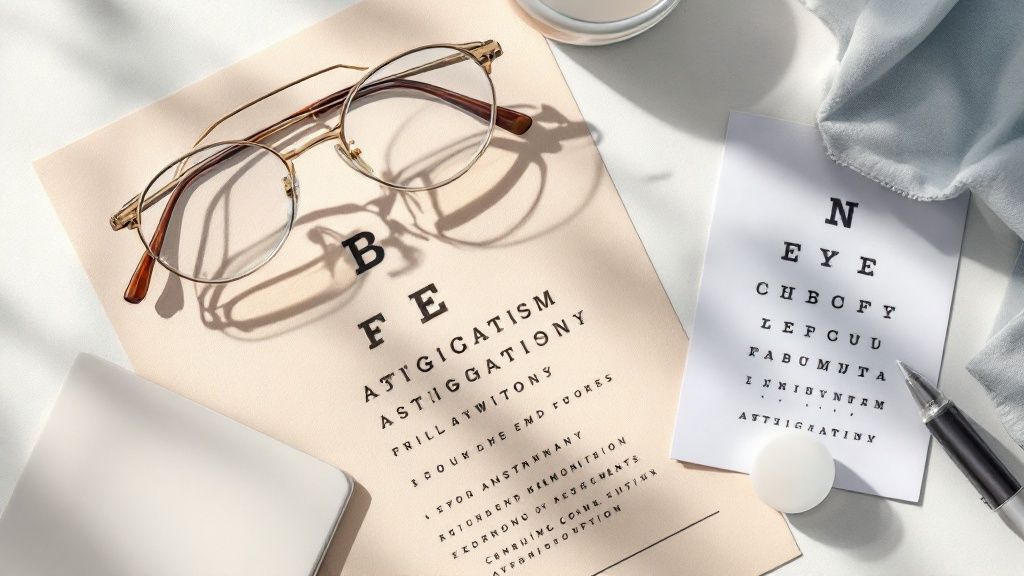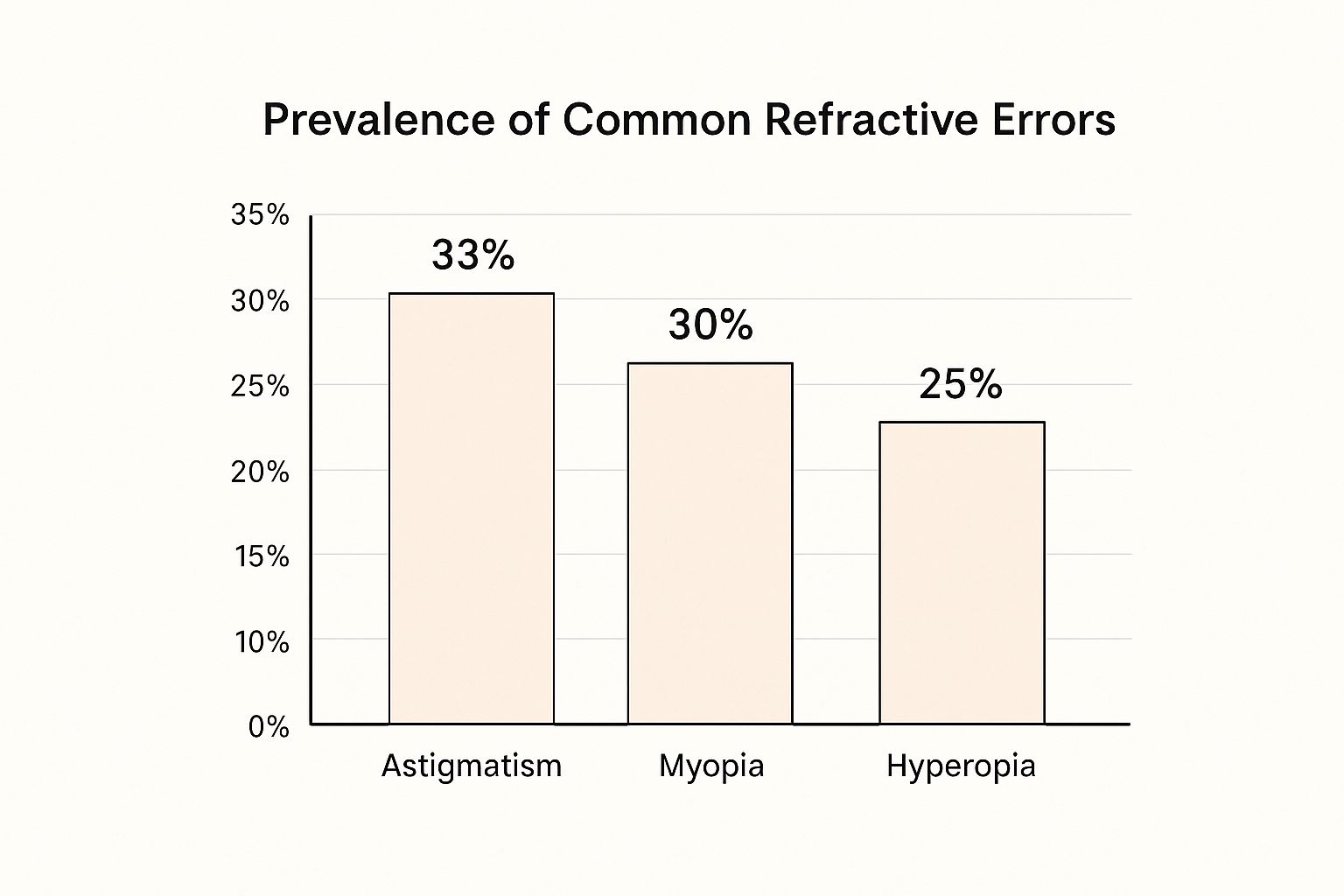Astigmatism is a very common, and often misunderstood, vision issue that affects many of us right here in Glendale Heights. It all comes down to the shape of your eye. When the cornea (the clear front part of the eye) or the lens inside isn't perfectly round, it causes your vision to be blurry or distorted at any distance.
Think of it this way: a normal eye is shaped like a basketball, perfectly round. This shape lets light focus on a single, sharp point on your retina. An eye with astigmatism, however, is shaped more like a football. This irregular curve scatters light, causing it to focus on multiple points instead of just one, which is why things look fuzzy.
What Is Astigmatism? A Closer Look
Have you ever felt like you're looking at the world through a funhouse mirror, where things are just a little stretched or out of focus? That's a great way to describe what living with astigmatism can feel like. In simple terms, it's a type of "refractive error," which is a technical term for a problem with how your eye bends—or refracts—light.
For those of us in Glendale Heights, getting a handle on this condition is the first step toward seeing clearly again. Whether you're driving down Bloomingdale Road or just trying to read a book, sharp vision makes all the difference.
And you're certainly not alone if you have it. Astigmatism is incredibly widespread. Studies in the United States show it affects a huge slice of the population, with estimates ranging from 11% to as high as 46%. It also becomes more common as we get older.
Defining the "Football-Shaped" Eye
That "football versus basketball" analogy really is the best way to picture what’s going on. A perfectly round cornea lets light rays hit the retina in a single, crisp point, giving you clear vision. But when the cornea is toric, or football-shaped, things get a bit messy.
This tiny imperfection in shape can lead to some really frustrating symptoms that creep into your daily life. You might start to notice:
- Blurry or distorted vision: This is the classic sign. It’s not just things far away or up close; everything can look a little off.
- Headaches and eye strain: Your eyes are constantly working overtime to try and focus, which can leave them feeling tired and sore, especially after screen time.
- Trouble with night vision: Glare from oncoming headlights or streetlights might look like starbursts or have halos around them.
- Needing to squint: You might find yourself squinting without even realizing it. It's a natural reflex to try and force your eyes to focus better.
To break it down even further, here's a quick summary of the key concepts.
Astigmatism at a Glance
| Concept | Simple Explanation |
|---|---|
| What It Is | A common vision problem caused by an irregularly shaped cornea or lens (the "football" shape). |
| The Main Cause | An imperfect curve on the eye's surface that scatters light instead of focusing it to a single point. |
| Primary Symptoms | Blurry or distorted vision at all distances, eye strain, headaches, and difficulty seeing at night. |
This table helps simplify the core ideas, but experiencing the symptoms is what really matters.
If any of those symptoms sound familiar, it's a strong signal that you should get your eyes checked by a professional. Guessing won't help, but an accurate diagnosis is the first step toward a real solution.
Thankfully, finding out if you have astigmatism is simple. The most reliable way to know for sure is to schedule one of our detailed eye exams in Glendale Heights. Here at iDoctor, we use state-of-the-art diagnostic tools to map the unique curve of your eye and figure out the exact prescription you need to see the world in high definition.
So, What's Really Behind Astigmatism?
Ever wonder what actually causes astigmatism? For most of us, the answer is surprisingly simple: it's in our genes. Most cases are hereditary, which just means you were born with a cornea or lens that isn't perfectly round. It’s not your fault; it’s just the unique way your eyes were built.
Think of a perfectly round eyeball as a camera lens that focuses light onto a single, sharp point. With astigmatism, the eye’s front surface (the cornea) or the lens inside is shaped a bit more like an oval or a football. This irregular curve scatters incoming light across multiple points on the retina instead of just one. That scattering effect is what creates the hallmark blurriness and distortion of astigmatism.
The Two Main Players: Corneal and Lenticular Astigmatism
To really get it, you need to know that astigmatism comes in two main flavors, depending on which part of the eye is irregularly shaped. The vision problems feel the same, but the source is different.
Corneal Astigmatism: This is the one most people have. It’s all about the cornea—the transparent dome covering the front of your eye. Instead of being shaped like a perfectly round basketball, it’s more like an American football. Since the cornea does most of the heavy lifting for focusing light, even a minor imperfection here can make a big difference in how you see.
Lenticular Astigmatism: This type is less common and involves the lens, which is located behind your iris. Here, the cornea might be perfectly round, but the lens itself has an uneven curve. This imperfection bends light improperly, causing the same blurry outcome.
It's also quite common for people to have a mix of both. During a detailed eye exam, our optometrist in Glendale Heights can pinpoint exactly what’s going on with your eyes.
The bottom line is this: both types of astigmatism are caused by a structural flaw in your eye’s focusing system. The goal of any treatment—be it glasses, contacts, or surgery—is to correct that flaw and give light a single, clear point to focus on.
Are There Other Causes?
While your family tree is the most likely culprit, astigmatism can occasionally pop up for other reasons. These are much rarer, but still worth knowing about.
For example, an eye injury that leaves a scar on the cornea can physically change its shape, leading to astigmatism. Certain eye surgeries, like cataract removal, can also sometimes alter the cornea's curvature as a side effect.
There’s also a more serious (and rare) condition called keratoconus. This is a progressive disease where the cornea gradually thins and starts to bulge into a cone-like shape. This change causes significant astigmatism and requires careful management by an eye doctor.
No matter the reason—from a simple trait passed down through your family to a more complex condition—the first step is always getting a proper diagnosis. Understanding the "why" behind your vision issues is the key to finding the best "how" to fix them. For all our patients, from students at nearby Glenbard West High School to longtime Glendale Heights residents, we find that a little understanding goes a long way in making the journey to clear vision a lot less daunting.
Recognizing the Signs and Symptoms
The symptoms of astigmatism can be sneaky. They often creep up so gradually that it’s easy to write them off as simple eye strain or fatigue, especially after a long day at the office or navigating traffic around Glendale Heights. But these little clues are your eyes telling you something is off, and recognizing them is the first step toward getting the clear, comfortable vision you deserve.
While blurry vision is the most famous symptom, the reality is a bit more nuanced. It’s not just a general fuzziness. Instead, objects at any distance can look distorted or stretched out. You might catch yourself squinting constantly to try and sharpen your focus, whether you're trying to read a menu in a restaurant or make out a street sign up ahead.
This constant struggle to see clearly can lead to some other uncomfortable side effects. Many people with undiagnosed astigmatism complain about frequent headaches, often felt around the forehead and temples. You might also notice a persistent feeling of eye fatigue, particularly after visually demanding tasks like reading or working on the computer.
Beyond Blurry Vision
Astigmatism messes with your vision in ways that go far beyond simple clarity. One of the most common and frustrating issues is trouble with night vision—something many Glendale Heights drivers know all too well.
Picture this: you're driving down Army Trail Road after dark. The headlights from oncoming cars don't look like crisp, clean points of light. Instead, they might seem smeared, surrounded by distracting halos or starburst patterns. This glare can make driving at night not just a hassle, but genuinely unsafe.
Here’s a quick checklist of common signs that might point to astigmatism:
- Distorted or Blurry Vision: Lines that should be straight can look wavy, and your vision just feels "off" at all distances—near, far, and everywhere in between.
- Constant Squinting: You instinctively narrow your eyes to try and force images into focus, often without even realizing you're doing it.
- Frequent Headaches: Your eyes are working overtime to compensate for the blur, which can lead to tension headaches.
- Eye Strain and Fatigue: After reading or screen time, your eyes feel tired, achy, or heavy.
- Poor Night Vision: You see halos, streaks, or starbursts around lights, which is especially noticeable when driving at night.
If you're nodding along to any of these symptoms, it's a clear signal that it's time to get your eyes checked. These visual struggles aren't something you just have to live with; they're indicators of an underlying, and very correctable, condition.
Why a Professional Diagnosis Matters
It’s tempting to connect these daily challenges to astigmatism on your own, and this checklist is a great starting point. But self-diagnosing can be tricky, as many of these symptoms can overlap with other vision problems. The only way to know for certain what’s causing your discomfort is through a comprehensive eye evaluation.
Scheduling one of our detailed eye exams in Glendale Heights lets our expert team precisely measure the unique curvature of your eye. Using advanced diagnostic tools, we can pinpoint the exact nature of your refractive error and map out a clear path to relief. Whether the best solution is a pair of stylish designer eyeglasses in Glendale Heights or custom-fitted contact lenses, it all starts with an accurate diagnosis.
How We Diagnose Astigmatism Accurately
Figuring out if you have astigmatism—and to what degree—is more involved than the classic "which is clearer, one or two?" test. It takes a comprehensive look at the unique structure of your eye. That's why at iDoctor, we dedicate a full 30 minutes to our detailed eye exams, using high-resolution imaging and advanced tools to get a complete picture of your vision and eye health right here in Glendale Heights.
We always start by talking with you about what you're experiencing with your vision day-to-day. From there, we move on to a series of precise tests designed to measure exactly how your eyes bend light.
The Tools We Use for a Precise Diagnosis
To really understand your vision, we rely on specialized instruments that give us objective, detailed data. When it comes to astigmatism, two of the most critical pieces of equipment are the corneal topographer and the phoropter.
Think of a corneal topographer as a high-tech cartographer for your eye's surface. This amazing, non-invasive device projects a pattern of light onto your cornea and analyzes the reflection. It then generates a detailed, color-coded 3D map of its curvature, instantly showing us any of those football-like irregularities that define astigmatism.
Then, you'll look through the phoropter—that's the familiar, mask-like instrument we use to dial in your prescription. By switching between different lenses, we can fine-tune the exact correction needed to give you the sharpest, clearest vision possible.
These tools allow us to go far beyond a simple screening. If you're curious about the entire process, you can read our guide on what to expect during an eye exam.
Making Sense of Your Astigmatism Prescription
After the exam, you’ll get a prescription with a few numbers that specifically relate to astigmatism. It can look a bit like a secret code at first, but knowing what these values mean puts you in the driver's seat of your eye health. For astigmatism, we're looking at two key numbers: Cylinder (CYL) and Axis.
- Cylinder (CYL): This tells us the amount of astigmatism. It’s the lens power required to correct for the two different curves on your eye. The higher the number, the more pronounced the football shape is.
- Axis: Measured in degrees from 1 to 180, this number pinpoints the orientation of the astigmatism. It’s essentially the angle of that football shape on your eye. This value tells the lab precisely where to position the correction in your glasses or contacts.
A complete prescription is a detailed blueprint for your vision. The Cylinder and Axis values work together to ensure your new lenses precisely counteract your eye's unique shape, turning blurry, distorted images into a crisp, clear view of the world.
At iDoctor, our best optometrist in Glendale Heights combines these advanced diagnostic results with a genuine understanding of your lifestyle. Whether you're a student at the College of DuPage or spend your days driving around Chicagoland, our meticulous exam process ensures we craft the perfect prescription for your designer eyeglasses in Glendale Heights or contact lenses.
Exploring Your Treatment Options for Clear Vision
Getting an astigmatism diagnosis is the first step, but the best part is what comes next: finding the right fix. The good news is that astigmatism is very correctable. Here at our Glendale Heights boutique, we’re all about finding a solution that fits your vision, your lifestyle, and your personal taste. Modern eye care gives us several fantastic ways to get you seeing clearly, and our team is here to walk you through all of them.
The most common and dependable solution for astigmatism is a great pair of prescription eyeglasses. Think of it less as a fix and more as a chance to show off your style.
Finding Your Perfect Pair of Eyeglasses
Glasses designed for astigmatism aren't just any lenses; they use a special cylindrical shape. This design is engineered to compensate for the irregular, football-like curve of your cornea or lens. By doing so, it directs light to a single, sharp focus point on your retina. The result? A crisp, undistorted view of everything around you.
We believe that your eyewear should say something about you. That's why we’ve put together a curated collection of designer eyeglasses in Glendale Heights, featuring some of the world's most recognized brands.
- Luxury & Iconic Styles: Make a statement with timeless frames from Cartier, Gucci, Tom Ford, Oliver Peoples, Fendi, Givenchy, Saint Laurent, and Prada.
- Modern & Accessible Brands: Find the perfect everyday pair from favorites like Ray-Ban, Scott Harris, Michael Kors, Kate Spade, and Coach.
Our skilled opticians will guide you in choosing a frame that not only looks great but also works flawlessly with your unique prescription.
Advanced Contact Lenses for Astigmatism
If you prefer a vision solution without frames, modern contact lenses are an amazing choice. Long gone are the days when having significant astigmatism meant contacts were off the table. Today’s lens technology offers options that are incredibly comfortable and effective.
The go-to choice is a type of lens called a toric contact lens. These are soft lenses built with a clever design that keeps them from rotating on your eye. This stability is key because it makes sure the astigmatism correction stays perfectly aligned, giving you consistently clear vision all day long. If this sounds like the right fit for you, our detailed guide on contact lenses for astigmatism has even more information.
Just how common is astigmatism? It helps to see it in context. This chart shows how it stacks up against other common vision issues.
As you can see, astigmatism is the most common of these refractive errors, affecting about a third of the population. This is exactly why so many great treatment options are available today.
Choosing the right correction method is a big decision, and it helps to see the options laid out side-by-side. Here’s a quick comparison of the most common ways to correct astigmatism.
Comparing Astigmatism Correction Methods
| Treatment Method | How It Works | Pros | Cons |
|---|---|---|---|
| Eyeglasses | A cylindrical lens counteracts the irregular curve of the cornea or lens, focusing light onto a single point on the retina. | Easy to use, wide style selection, provides clear vision, requires minimal maintenance. | Can be inconvenient for sports, peripheral vision can be distorted, can fog up. |
| Toric Contact Lenses | Soft lenses with a special design that keeps them stable on the eye to provide consistent astigmatism correction. | Provides a natural field of view, great for active lifestyles, no frames to worry about. | Requires daily cleaning and care, risk of eye infection if not handled properly. |
| Refractive Surgery (LASIK) | A laser permanently reshapes the cornea to correct its irregular curve, allowing light to focus properly. | A long-term, potentially permanent solution, eliminates the daily need for glasses or contacts. | Not suitable for everyone, involves surgical risks, higher initial cost. |
Each path offers its own set of benefits. The best one for you really depends on your eyes, your daily activities, and your personal preferences.
Your vision is unique, and your treatment should be too. Whether you love the fashion-forward appeal of designer frames or the freedom of advanced contact lenses, our goal is to find a solution that enhances both your vision and your life.
Globally, the impact of astigmatism is massive. Research into its prevalence shows that approximately 40.4% of adults and 14.9% of children worldwide have the condition, making it one of the most widespread vision disorders. Understanding these numbers is crucial for ensuring that effective corrective solutions are accessible to everyone who needs them.
Considering a More Permanent Solution
For those looking for an alternative to the daily routine of glasses or contacts, refractive surgery is worth considering. Procedures like LASIK work by using a laser to permanently reshape the cornea. By correcting its irregular curve, the surgery allows light to focus properly without the need for corrective lenses.
While these surgical options can be life-changing, they aren’t a fit for everyone. A comprehensive evaluation with an ophthalmologist is essential to determine if you are a good candidate, which depends on factors like your prescription, corneal thickness, and overall eye health. Our team can provide an initial consultation to help you understand all the pathways to clear vision.
Childhood Astigmatism and Early Detection
A child's world is built on what they see. From learning in the classroom at Marquardt Middle School to playing on the soccer field at Camera Park, clear vision is fundamental. But when a child has undiagnosed astigmatism, it’s like they're trying to navigate the world through a slightly warped window.
This is why catching it early is so important for our youngest patients here in Glendale Heights. It's easy for parents to assume everything is fine if their child isn't complaining, but kids often don't have the words to describe blurry vision. To them, fuzzy might just be normal.
Why Early Eye Exams Are Essential
The single best way to catch astigmatism is through a comprehensive pediatric eye exam. Without it, a simple vision issue can be misread as a learning disability or an attention problem, all because the child can't see the whiteboard or their textbook clearly.
As a parent, you can also be on the lookout for subtle clues that signal it's time to see the best optometrist in Glendale Heights.
- Frequent Squinting: Does your child often squint or cover one eye? They might be trying to force a blurry image into focus.
- Head Tilting: This is a classic sign. Children will often tilt their heads to unconsciously find a better angle for seeing.
- Avoiding Reading: If reading or close-up activities lead to complaints of headaches, it could be due to eye strain from uncorrected astigmatism.
- Sitting Too Close: You might notice your child getting right up on the TV or holding a tablet inches from their face to see it better.
The connection between a child's environment and their eye health is clearer than ever. Recent studies revealed that the prevalence of refractive astigmatism in children aged 6 to 8 jumped from 23.4% before the pandemic to around 34.7% in 2022-2023. This spike is strongly linked to lifestyle shifts like more screen time and less time outdoors, highlighting just how crucial proactive eye care has become. Learn more about these important findings on astigmatism in children.
Fortunately, correcting astigmatism in kids is usually straightforward and can make a world of difference in their confidence and school performance. Most of the time, all it takes is a durable, kid-friendly pair of glasses.
If you're not sure where to start, our guide on your child's first eye exam in Glendale Heights can walk you through the process. We're committed to making sure every child in our community has the clear vision they deserve to thrive.
Astigmatism FAQs for Glendale Heights Residents
Here at our Glendale Heights office, we get a lot of great questions about astigmatism. To help clear things up, we've put together answers to some of the ones we hear most often.
Where can I find stylish designer eyeglasses in Glendale Heights?
You've come to the right place! At iDoctor, we believe correcting your vision is a great opportunity to enhance your personal style. We carry a hand-picked collection of luxury eyewear from top brands like Cartier, Gucci, and Tom Ford, as well as timeless favorites like Ray-Ban. Our expert opticians are fantastic at helping you find a frame that not only looks great but also fits your face and prescription perfectly.
Does my vision insurance cover astigmatism correction?
Yes, almost always. Astigmatism is a very common refractive error, so vision insurance plans typically cover the corrective lenses you need, whether that's for glasses or contact lenses in Glendale Heights. We accept all major vision insurance plans at iDoctor and our team is always ready to help you make sense of your benefits and get the most out of your coverage.
Can astigmatism get worse over time?
It can definitely change, which is why we emphasize the importance of annual eye exams. While many people have a stable prescription for years, it's not unusual for astigmatism to shift, especially during childhood and then again as we get older. Our eye doctor in Glendale Heights recommends yearly check-ups to stay on top of any changes and ensure your vision is always at its best.
Your prescription numbers tell the full story. The "cylinder" and "axis" values indicate the severity and orientation of your astigmatism. You can learn more by exploring our detailed guide to understanding your eye prescription numbers.
While we're talking about eye health, it's not just about clear vision. If you ever deal with dryness or irritation, you might want to look into the benefits of warm eye compresses for dry eyes and MGD.
Ready to see Glendale Heights in stunning clarity? Schedule your detailed eye exam at iDoctor today and let our experts help you find the perfect vision solution for your life.








